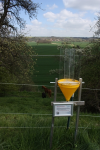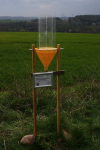Bee and Hoverfly Monitoring
In 2001 we started as part of the EU FP5 project Greenveins monitoring of insect communities in the normal landscape of Saxony-Anhalt (Germany), which is dominated by agricultural use. We selected four landscape sites (close to the villages of Friedeburg, Greifenhagen, Schafstaedt, Wanzleben) of 4x4 km and recorded insects using combined flight traps, combining the effects of window and yellow pan traps (see Duelli et al., 1999). Follow-up yearly sampling started in 2010 as long-term monitoring within the TERENO project (www.tereno.net), contributing to the LTER network (Long-Term Ecosystem Research) in Germany (www.lter-d.de) and internationally as well (www.lter-europe.net). In 2010 another two landscape sites were added (Harsleben, Siptenfelde).
Traps consist of a yellow funnel (25 cm diameter) filled with water (preserving agent added) and two perspex windows mounted in a way that they are crossed in the center. Within each square km of a site one trap was placed at ecotones between semi-natural habitats and agricultural fields (16 traps per site). Traps were operated in late spring-early summer (three sampling rounds) and late summer (three sampling rounds). They were left open for 2 weeks before being emptied. The trap material was collected six times per year. Subsequently, all bees were identified to species level.
Metadata about the sites and related activities and data sets can be found in the DEIMS Repository for Research Sites and Datasets (https://data.lter-europe.net/deims/).

